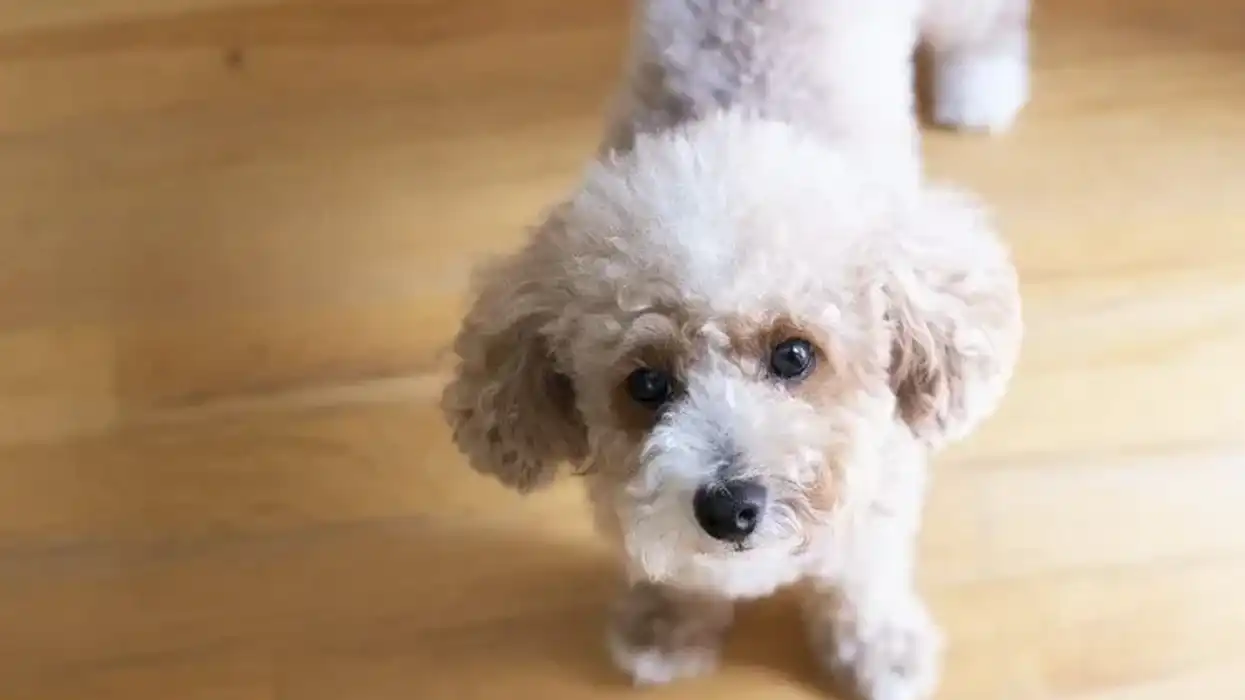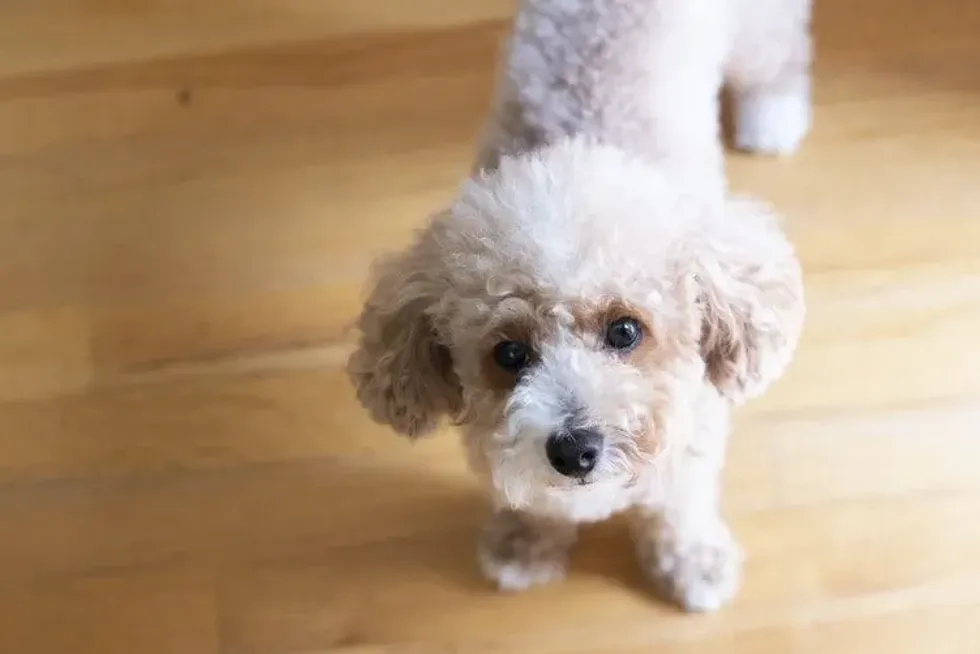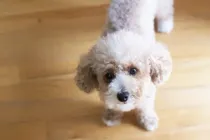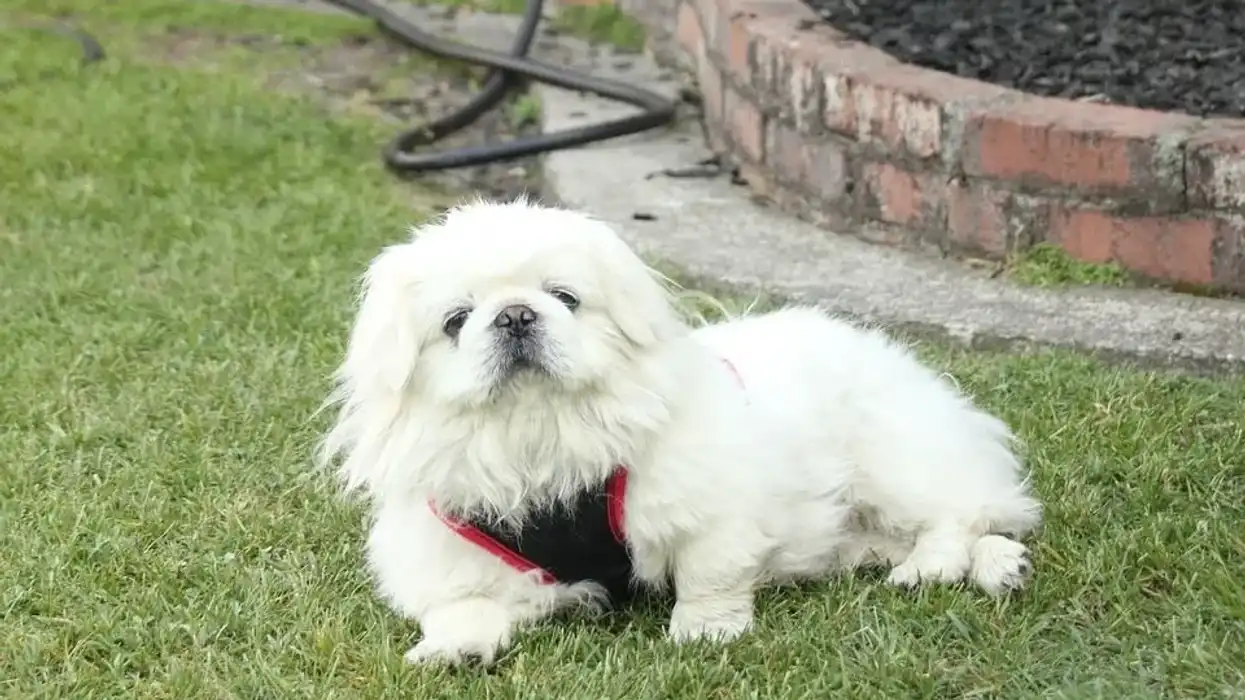Fun Toy Poodle Facts For Kids

A toy poodle belongs to the poodle breed that comes in three varieties, including toy poodles, standard poodles, and miniature poodles. The poodle is the national dog of France and is known as Caniche which means a 'duck dog'.
The toy poodle is regarded as the smallest among the poodle breed but shares the same temperamental and physical features as others belonging to the poodle breed.
They are highly intelligent, smart, outgoing, and easy to train dogs that are great for being a family pet. Toy miniature breed dogs are an absolutely bundle of joy who can make any home a happy place.
Toy poodles are generally very friendly with other pet dogs as well as other pet animals. They have medium to high energy level and require regular walks and exercise to maintain their health.
Toy poodles are often found living in multi-pet households peacefully with the owners. Poodle owners are required to take care of their diet and grooming to prevent health issues like hair loss. You may also look at Australian terrier and Tibetan mastiff after reading about Miniature Poodle.
Toy Poodle Interesting Facts
What type of animal is a toy poodle?
A toy poodle is a dog belonging to the poodle breed. These poodles are still relevant and popular choices as pets even today among various celebrities and royal families. They are smart, active, and fluffy creatures that are great as family pets.
What class of animal does a toy poodle belong to?
Toy poodles belong to the class of mammals and have evolved from breeding small poodles with one another.
How many toy poodles are there in the world?
It is practically impossible to calculate the number of poodles in this world, but they are not rare creatures. They are one of the smartest toy dog breeds in this world and are in high demand among owners and breeders.
They are also the national animal of France, which represents their population and existence in France and Western countries. Recently the breeders have been trying to form an even smaller breed of poodles called the tea-sized poodles.
Where does a toy poodle live?
Poodles are nowhere near being wild, they are domestic animals now. They were first used as hunting dogs and were known to be great swimmers from where they got their other name, 'duck dogs'.
What is a toy poodle's habitat?
Toy poodles do not have an undercoat and are very sensitive to climate changes. They have really sensitive skin as they don't have much hair. Mini poodle may be fine in warm or moderately cold climates, whereas they are sensitive to cold as it exposes their joints and body to diseases.
Who do toy poodles live with?
Poodles are regarded as the second smartest and most intelligent dog breeds around the world. Poodles are very fit to live with people and are not found in packs. They are great companion dogs but can suffer from separation anxiety if left alone for too long.
How long does a toy poodle live?
Toy poodles are hypoallergenic creatures that have a life span of 12-15 years, which is fairly long compared to other dog breeds. Female toy poodles are believed to live a year or two more than male toy poodles. They require proper training and grooming to maintain their weight and health.
How do they reproduce?
Toy poodles are known to reproduce by giving birth to their young ones. They reach their sexual maturity around the age of 12-15 months and can mate after that.
A toy poodle generally gives birth to several toy poodle puppies at once, and can also give birth up to five at once. The largest litter size for toy poodles recorded to this day is 16.
What is their conservation status?
The toy poodle is a smart, brave, dog that is loved by all pet owners and breeders. Their conservation status is nowhere near being extinct.
They are known to be very common dogs that breeders and pet owners absolutely love. There are currently three different varieties of dog poodles in the world, and breeders are even trying to find and form other varieties of poodles due to their high demand for pet dogs.
Toy Poodle Fun Facts
What do toy poodles look like?
Toy poodles are cute little fluff balls and have a square built. Toy poodles are no different than their other varieties.
The only thing that differentiates a toy poodle from a miniature and standard poodle is its size. A toy poodle can be recognized as it is usually really small, about 10 in or less.
They have dark oval eyes, with a distinctive coat that requires regular grooming. Toy poodles are also known for a huge variety of colors including different shades of black, brown, white, cream, and also the mixture of these colors making them appear as a teacup poodle.

How cute are they?
If you thought that soft toys and your favorite stuffed toy are the cutest things, we are sorry to break it to you that there are equally cute living creatures that are called toy poodles. They are very cute, friendly, smart, and fluffy.
Toy poodles are also regarded as one of the cutest small dogs that are fluffy and resemble a toy to play around with after proper training.
How do they communicate?
Toy poodles are known to make different sounds and actions to communicate with their owners. They are really smart and can learn around 400 different words and commands through their life which makes it easier for them as well as their owners to communicate.
How big is a toy poodle?
A toy poodle is a really small dog that is 10 in tall and weighs around 6-9 lb. They are almost half and even smaller than the other variety of their same breed which is a standard poodle.
How fast can a toy poodle run?
Poodles are athletic creatures that can run and swim really fast. The smallest size of poodles, toy poodles, can run at an average speed of 10 mph, whereas a standard poodle can almost run at an average speed of 30 miles per hour, if given proper training.
How much does a toy poodle weigh?
A toy poodle usually weighs around 6-9 lb on average and male toy poodles are comparatively heavier than female toy poodles.
What are their male and female names of the species?
There are no specific names given to the male and female toy poodles. They are generally regarded as male toy poodle and female toy poodle.
What would you call a baby toy poodle?
A baby toy poodle is regarded as a toy poodle puppy that is really small and resembles a cute fluff ball.
What do they eat?
Toy poodles are really active and can eat up to four meals a day when they are puppies. A toy poodle generally requires around 117 kcal/day at two months old, 176 kcal /day at four months old, and around 208 kcal/day till and after they are 12 months old.
Every dog has a different nutritional requirement. Therefore it is suggested to consult a vet to decide and form a diet for your toy poodle. Proper training is required to regulate their eating habits.
Are they slobbery?
If you are allergic and worry about dogs drooling or being slobbery, a toy poodle might be a great choice for you. Dogs of this breed do not drool much, and their clean face and lips completely discourage drooling as they need maintenance and should be given baths frequently to keep their coat clean and in shape.
Would they make a good pet?
Toy poodles are one of the smartest and cutest dog breeds. They are really friendly but are not best suited to be around kids.
They are really family-friendly if trained properly but need more grooming compared to other dogs and breeds. On the other hand, being smart, they are really easy to train and act as excellent companion dogs.
But they are also known to suffer from separation anxiety if left alone for too long. Like other dogs, they are also very prone to various health issues like skin diseases, heart disorders, and digestive problems which can make them a bit high maintenance compared to other dogs.
Did you know...
Although toy poodle breed dogs are known to have great genetic history, there are some vulnerabilities that you need to look out for. Here are some of the most important facts you need to know before deciding on buying or adopting a toy poodle.
Toy poodles are known to suffer from progressive retinal atrophy, which causes the retina at the back to eventually degenerate and which ultimately results in loss of sight. This can be caused due to faulty inherited genes or plain bad luck.
Toy poodles are known to suffer from cataracts as well. So, it is extremely important to screen and have a complete eye exam with a vet at regular intervals.
Small toy poodles are also prone to patella luxation, which is a malformation of the knee joint that can cause lameness.
One other important disease to look into while buying or adopting your toy poodle is von Willebrand's Disease which is an inherited blood disease that makes it difficult to clot blood and causes excessive bleeding from wounds or cuts.
Another concerning disease to poodle health is skin tumors. Skin tumors are the result of the formation of abnormal cells anywhere in the body.
They are visible to the human eye as they appear as big lumps. The only way of removing them is through surgical procedures. A biopsy of a poodle will determine the type of tumor a dog has.
These cute little dogs can also suffer from bladder stones similar to humans. These stones will cause uneasiness to your dog and can be harmful as well. If you see blood in the urine of your dog, then contact a vet immediately.
How to train a toy poodle?
Do not let the small size of a toy poodle breed fool you. They are very active dogs that need as equal grooming and regular exercise as other dogs.
They are very friendly and obedient, which makes them easy to train. Toy poodles are very smart dogs and are highly trainable. Dogs of this breed are very responsive and eager to please, so reward-based training using their favorite food or snack would be the best option.
Why do poodles usually have the same haircut?
Poodles have been slaying the same haircut for a considerable amount of time now. This is to safeguard these little creatures from any unwanted disease, making it a necessity rather than a style.
Historically it was believed that such a haircut was styled in order to make life easier for them, such as their chest hair which was kept intact in order to keep their vital organs covered and warm in cold weather.
The bottom half was shaved to make it easier for them to swim freely.
The hair around their joints was not shaved and this was to safeguard their joints. The hair around the face, mouth and eyes were shaved in order to keep these parts functioning properly and their hair is tied on the head in a top bun to avoid it from poking their eyes.
The same hairstyle was used for poodles, not out of style but out of necessity, which is seen in present times as well. Even till this day poodles hairstyle have evolved but are seen to include all the old factors and essentials intact.
They rock the most common coat patterns, or hairstyles called Continental or the English Saddle.
Here at Kidadl, we have carefully created lots of interesting family-friendly animal facts for everyone to discover! Learn more about some other mammals including Pekingese, or eskimo dog.
You can even occupy yourself at home by drawing one on our Toy poodle coloring pages.
We Want Your Photos!
More for You
See All
Bachelors in Business Administration

Aashita DhingraBachelors in Business Administration
Based in Lucknow, India, Aashita is a skilled content creator with experience crafting study guides for high school-aged kids. Her education includes a degree in Business Administration from St. Mary's Convent Inter College, which she leverages to bring a unique perspective to her work. Aashita's passion for writing and education is evident in her ability to craft engaging content.
Bachelor of Arts specializing in Psychology

Shreya YadavBachelor of Arts specializing in Psychology
Shreya has developed a diverse set of skills through her experience in client servicing, email marketing, content and e-commerce management, digital marketing, and creative content writing. Her educational background includes a Bachelor's degree in Psychology from Indira Gandhi National Open University, Delhi. Shreya's passion for ongoing learning and development is a testament to her commitment to excellence.
Disclaimer
1) Kidadl is independent and to make our service free to you the reader we are supported by advertising. We hope you love our recommendations for products and services! What we suggest is selected independently by the Kidadl team. If you purchase using the Buy Now button we may earn a small commission. This does not influence our choices. Prices are correct and items are available at the time the article was published but we cannot guarantee that on the time of reading. Please note that Kidadl is a participant in the Amazon Services LLC Associates Program, an affiliate advertising program designed to provide a means for sites to earn advertising fees by advertising and linking to Amazon. We also link to other websites, but are not responsible for their content.
2) At Kidadl, we strive to recommend the very best activities and events. We will always aim to give you accurate information at the date of publication - however, information does change, so it’s important you do your own research, double-check and make the decision that is right for your family. We recognise that not all activities and ideas are appropriate for all children and families or in all circumstances. Our recommended activities are based on age but these are a guide. We recommend that these ideas are used as inspiration, that ideas are undertaken with appropriate adult supervision, and that each adult uses their own discretion and knowledge of their children to consider the safety and suitability. Kidadl cannot accept liability for the execution of these ideas, and parental supervision is advised at all times, as safety is paramount. Anyone using the information provided by Kidadl does so at their own risk and we can not accept liability if things go wrong.
3) Because we are an educational resource, we have quotes and facts about a range of historical and modern figures. We do not endorse the actions of or rhetoric of all the people included in these collections, but we think they are important for growing minds to learn about under the guidance of parents or guardians.







